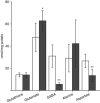Quantitative importance of the pentose phosphate pathway determined by incorporation of 13C from [2-13C]- and [3-13C]glucose into TCA cycle intermediates and neurotransmitter amino acids in functionally intact neurons
- PMID: 22714050
- PMCID: PMC3434630
- DOI: 10.1038/jcbfm.2012.85
Quantitative importance of the pentose phosphate pathway determined by incorporation of 13C from [2-13C]- and [3-13C]glucose into TCA cycle intermediates and neurotransmitter amino acids in functionally intact neurons
Abstract
The brain is highly susceptible to oxidative injury, and the pentose phosphate pathway (PPP) has been shown to be affected by pathological conditions, such as Alzheimer's disease and traumatic brain injury. While this pathway has been investigated in the intact brain and in astrocytes, little is known about the PPP in neurons. The activity of the PPP was quantified in cultured cerebral cortical and cerebellar neurons after incubation in the presence of [2-(13)C]glucose or [3-(13)C]glucose. The activity of the PPP was several fold lower than glycolysis in both types of neurons. While metabolism of (13)C-labeled glucose via the PPP does not appear to contribute to the production of releasable lactate, it contributes to labeling of tricarboxylic acid (TCA) cycle intermediates and related amino acids. Based on glutamate isotopomers, it was calculated that PPP activity accounts for ~6% of glucose metabolism in cortical neurons and ~4% in cerebellar neurons. This is the first demonstration that pyruvate generated from glucose via the PPP contributes to the synthesis of acetyl CoA for oxidation in the TCA cycle. Moreover, the fact that (13)C labeling from glucose is incorporated into glutamate proves that both the oxidative and the nonoxidative stages of the PPP are active in neurons.
Figures




References
-
- Appel SH, Parrot BL. Hexose monophosphate pathway in synapses. Journal of neurochemistry. 1970;17:1619–1626. - PubMed
-
- Bakken IJ, White LR, Aasly J, Unsgard G, Sonnewald U. Lactate formation from [U-13C]aspartate in cultured astrocytes: compartmentation of pyruvate metabolism. Neurosci Lett. 1997;237:117–120. - PubMed
Publication types
MeSH terms
Substances
LinkOut - more resources
Full Text Sources
Other Literature Sources

